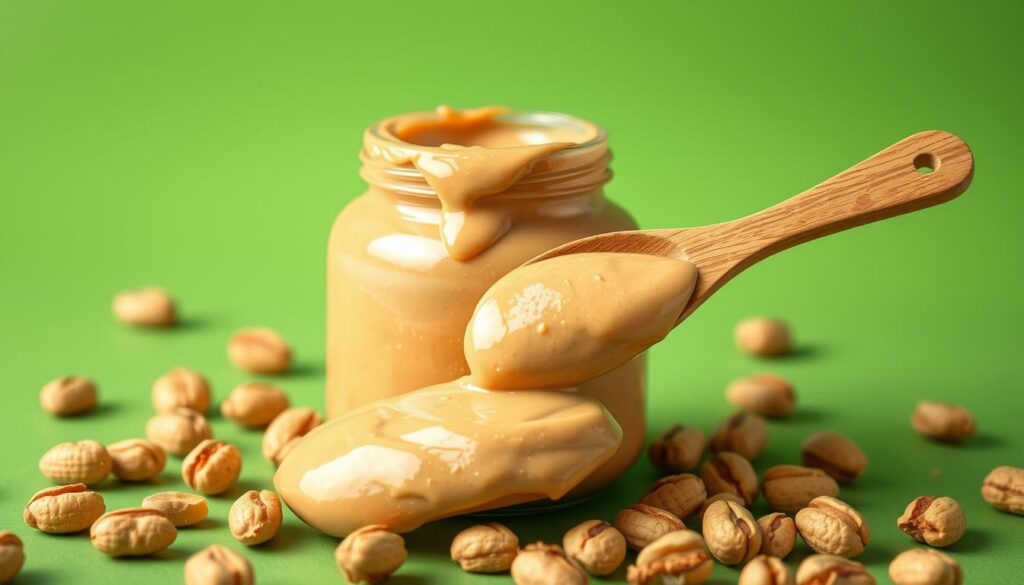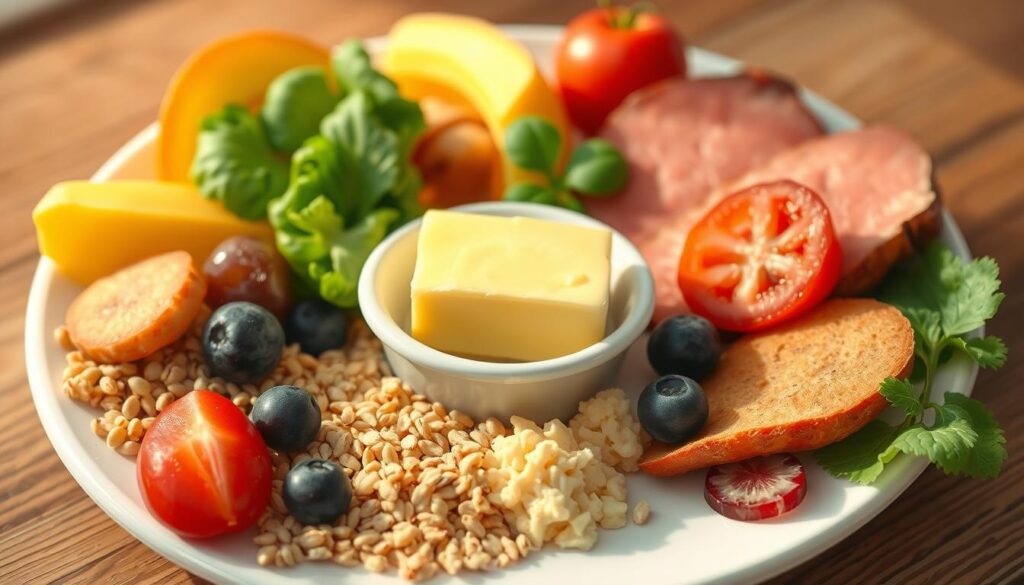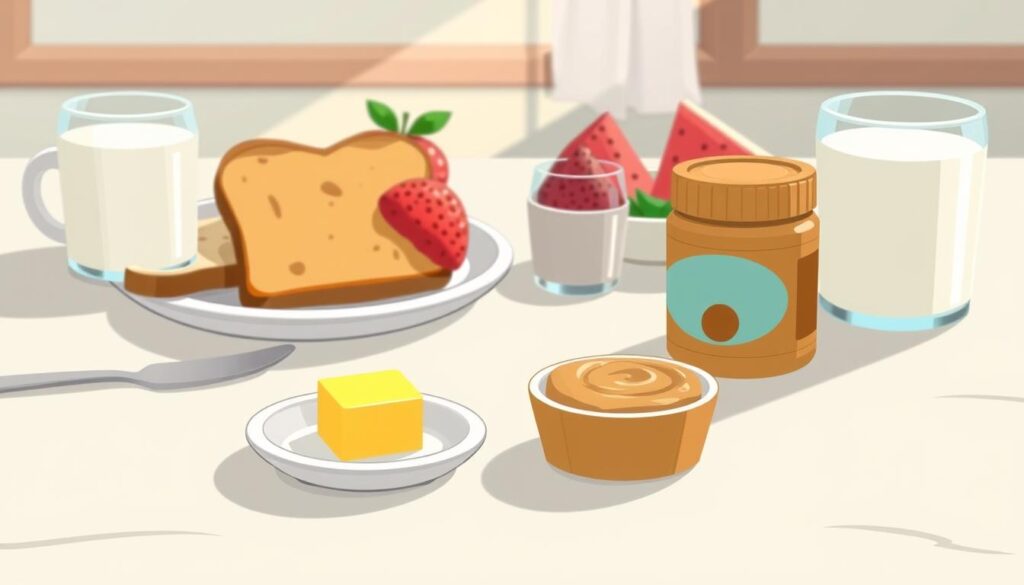The debate between butter and peanut butter is big in nutrition. Both are favorites in many homes, but they differ in nutrition. Luckily, Dr. Good Deed, a top nutritionist, explains the main differences. This helps you choose better for a healthy diet.
Table of Contents
ToggleIf you love butter or peanut butter, this comparison is for you. It looks at the healthy fats, protein, vitamins, and minerals in each. Knowing the differences lets you use them in your diet for better health.
Introduction to Butter and Peanut Butter
Butter and peanut butter are staples in many homes. They come from natural sources but differ in nutrition and taste. Knowing the differences helps you choose wisely for your diet.
Understanding the Differences
Butter comes from churning cream or milk. It’s mostly milk fat, with some water and solids. Peanut butter, on the other hand, is ground peanuts, sometimes with salt or sugar.
Butter has more saturated fats than peanut butter. Peanut butter has more unsaturated fats, protein, fiber, and vitamins. This makes peanut butter a healthier option for some.
Knowing these differences helps you eat them wisely. It’s about balance and health.
Nutritional Profile of Normal Butter
Butter is loved for its creamy texture and flavor. It also has a special nutritional profile. We’ll look at the fats, vitamins, and minerals in normal butter.
Fats, Vitamins, and Minerals in Butter
Butter has a lot of fat, with 81 grams in every 100 grams. This is more than peanut butter, which has about 50 grams. The fats in butter are both saturated and unsaturated.
Butter also has vitamins and minerals. It has vitamins A, D, E, and K. Plus, it has calcium, phosphorus, and selenium. These help with bone health, the immune system, and overall health.
Even though butter is seen as a treat, it can be part of a healthy diet. Knowing its nutritional value helps you use it wisely in your meals and snacks.
Nutritional Profile of Peanut Butter
Peanut butter is a tasty and healthy food. It’s made by grinding roasted peanuts into a smooth paste. This spread is full of important nutrients.
Peanut butter has lots of healthy fats, about 49.2 grams per 100 grams. These fats help lower cholesterol and heart disease risk. It also has 25.8 grams of protein per 100 grams, great for vegetarians.
It’s also rich in dietary fiber, with 8.5 grams per 100 grams. Fiber keeps your digestive system healthy and helps you feel full. Plus, peanut butter is full of vitamins and minerals like biotin and magnesium.
Eating peanut butter may help with weight, heart health, and gallstones. Its mix of healthy fats, protein, fiber, and vitamins makes it a great diet addition.
Enjoy peanut butter on toast, in smoothies, or as a dip. It’s a tasty way to add nutrition to your meals and snacks.
Protein Content: Butter vs. Peanut Butter
Butter and peanut butter differ mainly in protein content. Peanut butter is a top choice for plant-based protein. A 2-tablespoon serving has about 8 grams of protein, which is 17% of its calories.
Butter, however, is mostly fat with very little protein. A 2-tablespoon serving has less than 0.1 grams of protein. This is much less than peanut butter.
Importance of Protein in Diet
Protein is key for good health and body functions. It helps build and fix tissues, controls hormones, and boosts the immune system. Eating enough protein keeps you full, helps muscles, and supports a healthy diet.
- Peanut butter is a good source of plant-based protein, providing 8 grams per 2-tablespoon serving.
- Butter, on the other hand, is a poor source of protein, with only trace amounts in a 2-tablespoon serving.
- Protein is essential for various bodily functions, including tissue repair, hormone regulation, and immune system support.
- Consuming protein-rich foods like peanut butter can help you feel fuller for longer, supporting weight management efforts.

Knowing the protein difference between butter and peanut butter helps you choose better. You can pick foods that fit your protein needs for a balanced diet.
Normal Butter vs. Peanut Butter: Dr. Good Deed’s Nutritional Comparison
The debate between normal butter and peanut butter is interesting. Dr. Good Deed, a well-known nutritionist, has studied these spreads. He wants to help you choose the best for your diet.
Butter mainly has saturated fats, which can be bad if eaten too much. Peanut butter, however, has healthier fats. These fats can help lower bad cholesterol and raise good cholesterol.
Butter is full of vitamins A and D, and selenium. Peanut butter is packed with vitamins E and B6, and minerals like magnesium and potassium. Both are good for a balanced diet.
Dr. Good Deed says it’s up to you to decide between butter and peanut butter. Both can be part of a healthy diet. Just remember to eat them in moderation for the best health.
Health Benefits of Butter
Butter has been seen as bad because of its fat. But, new studies show it might be good for us. It can add important nutrients to our diet.
Role of Butter in a Balanced Diet
Butter has vitamins and minerals that help our health. It has vitamin A for our eyes, immune system, and skin. It also has vitamin K for blood and bones.
Butter has fats that are good for us in small amounts. It has saturated, monounsaturated, and polyunsaturated fats. These fats can help our heart and cholesterol levels.
Adding butter to a diet full of whole foods is smart. It lets us enjoy butter’s taste and health benefits. This way, we eat well and stay healthy.

Health Benefits of Peanut Butter
Peanut butter is more than a tasty spread. It’s packed with nutrients that boost your health. It helps your heart and aids in weight control, making it a great addition to your meals.
It’s high in protein, with 7 grams in just two tablespoons. This plant-based protein keeps you full and satisfied. It’s key to aim for 20-30 grams of protein at each meal.
Peanut butter also has lots of dietary fiber, about 2 grams per tablespoon. This fiber is good for your heart, diabetes, and digestion. It helps lower blood sugar and cholesterol, and aids in regular bowel movements.
It’s also full of healthy fats, like monounsaturated and polyunsaturated fatty acids. These fats reduce inflammation, keep your heart rhythm steady, and improve blood cholesterol.
Peanut butter is rich in vitamins and minerals too. It has copper, magnesium, manganese, niacin, phosphorus, vitamins B6 and E, and zinc. These nutrients are vital for your health and well-being.
Studies show eating peanuts or peanut butter for breakfast can curb hunger for up to 12 hours. It can also help you maintain a healthy weight. People who eat nuts tend to have a better Body Mass Index (BMI) than those who don’t.
But, peanut butter is high in calories, with nearly 100 calories per tablespoon. So, it’s best to eat it in small amounts, no more than two tablespoons at a time.
In summary, peanut butter is a nutritious food with many health benefits. It’s rich in protein, fiber, healthy fats, and essential vitamins and minerals. Adding peanut butter to your diet can be a tasty way to support your health.
Potential Drawbacks of Butter Consumption
Moderation is Key
Butter has some health benefits, but it also has drawbacks. It’s high in saturated fat. Too much can harm your heart and cholesterol levels.
The National Institutes of Health-AARP Diet and Health Study found something interesting. Eating nuts was linked to lower death rates. But, eating peanut butter didn’t show the same effect.
To enjoy butter safely, eat it in small amounts. Pair it with foods rich in nutrients. This way, you can get the good from butter without the bad.

Always remember, moderation is key. Butter can be part of a healthy diet if you don’t overdo it. This helps keep you healthy and happy.
Potential Drawbacks of Peanut Butter Consumption
Peanut butter is nutritious but has some downsides. Eating too much can harm your health. It has a lot of fat and calories. A 2-tablespoon serving has almost 200 calories and 16 grams of fat.
This can lead to weight gain if not eaten in balance. People with peanut allergies need to be careful. Peanut butter can cause serious allergic reactions.
It’s important to know if you or your family has peanut allergies. Also, peanut butter might affect some medicines. This includes blood thinners and diabetes meds. Always talk to a doctor before adding peanut butter to your diet.
Some peanut butters have added sugars and oils. These can lower its nutritional value. Choose natural peanut butters with just peanuts and a bit of salt.
To enjoy peanut butter healthily, eat it in moderation. It’s good for you but should be part of a balanced diet. Pick high-quality peanut butter to get the most benefits.
Incorporating Butter and Peanut Butter into a Healthy Diet
Enjoying butter and peanut butter while staying healthy is a challenge. But, with a few easy tips, you can enjoy these spreads and still eat well.
Tips for Responsible Consumption
To enjoy butter and peanut butter the right way, try these tips:
- Practice moderation – Stick to 1-2 tablespoons a day. Watch your calorie intake too.
- Choose high-quality options – Pick natural, simple butter and peanut butter. Avoid added sugars and unhealthy oils.
- Diversify your diet – Eat butter and peanut butter with lots of other healthy foods.
- Pair with complementary ingredients – Mix them with fruits, veggies, whole grains, and lean proteins for a better meal or snack.
- Explore alternative nut butters – Try almond, cashew, or walnut butter for more variety and nutrients.
By following these tips, you can enjoy butter and peanut butter without harming your health. It’s all about eating them in a balanced way.

Conclusion
This article has given a detailed look at butter and peanut butter’s nutritional values. It shows the good and bad sides of each. This helps you choose wisely to add them to your diet in a healthy way.
Butter and peanut butter can both be part of a healthy life. You can enjoy their unique tastes and health benefits. Just remember to eat them in the right amounts for your health.
It’s not about cutting out foods, but using them wisely. Knowing what butter and peanut butter offer helps you make better choices. Use these spreads in your meals and snacks for a more balanced and tasty diet.
FAQ
What is the key difference between the nutritional profiles of normal butter and peanut butter?
Butter is mostly fat. Peanut butter has healthy fats, protein, and fiber.
How do the types of fats in butter and peanut butter differ?
Butter has saturated fats. Peanut butter has unsaturated fats like monounsaturated and polyunsaturated fats.
What are the key vitamins and minerals found in butter and peanut butter?
Butter has vitamins A and D, and minerals like calcium and sodium. Peanut butter is rich in vitamins E and B6, and minerals like magnesium and potassium.
How do the protein contents of butter and peanut butter compare?
Peanut butter has more protein than butter. It’s a better source of this important nutrient.
What are the potential health benefits associated with the consumption of butter and peanut butter?
Butter adds nutrients to a balanced diet. Peanut butter supports heart health, weight management, and nutrient absorption.
What are the potential drawbacks of consuming butter and peanut butter in excess?
Too much butter can harm heart health. Too much peanut butter can be risky for those with allergies or who eat too much.
How can butter and peanut butter be incorporated into a healthy, balanced diet?
Use these spreads wisely. Eat a variety of nutrient-rich foods. This ensures a diet that supports your health.
Source Links

This article is medically reviewed by Dr. Chandril Chugh, Board-Certified Neurologist, providing expert insights and reliable health information.
Dr. Chandril Chugh is a U.S.-trained neurologist with over a decade of experience. Known for his compassionate care, he specializes in treating neurological conditions such as migraines, epilepsy, and Parkinson’s disease. Dr. Chugh is highly regarded for his patient-centered approach and dedication to providing personalized care.








